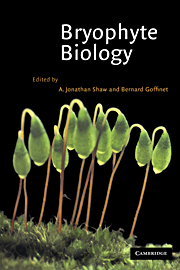Book contents
- Frontmatter
- Contents
- List of contributors
- Preface
- 1 Anatomy, development, and classification of hornworts
- 2 Morphology and classification of the Marchantiophyta
- 3 Morphology and classification of mosses
- 4 Origin and phylogenetic relationships of bryophytes
- 5 Chemical constituents and biochemistry
- 6 Molecular genetic studies of moss species
- 7 Control of morphogenesis in bryophytes
- 8 Physiological ecology
- 9 Mineral nutrition, substratum ecology, and pollution
- 10 Peatlands: ecosystems dominated by bryophytes
- 11 Role of bryophyte-dominated ecosystems in the global carbon budget
- 12 Population ecology, population genetics, and microevolution
- 13 Bryogeography and conservation of bryophytes
- Index
13 - Bryogeography and conservation of bryophytes
Published online by Cambridge University Press: 05 June 2012
- Frontmatter
- Contents
- List of contributors
- Preface
- 1 Anatomy, development, and classification of hornworts
- 2 Morphology and classification of the Marchantiophyta
- 3 Morphology and classification of mosses
- 4 Origin and phylogenetic relationships of bryophytes
- 5 Chemical constituents and biochemistry
- 6 Molecular genetic studies of moss species
- 7 Control of morphogenesis in bryophytes
- 8 Physiological ecology
- 9 Mineral nutrition, substratum ecology, and pollution
- 10 Peatlands: ecosystems dominated by bryophytes
- 11 Role of bryophyte-dominated ecosystems in the global carbon budget
- 12 Population ecology, population genetics, and microevolution
- 13 Bryogeography and conservation of bryophytes
- Index
Summary
Introduction
Except for the marine environment, bryophytes, as a group, are nearly cosmopolitan in distribution. Because of the small size of spores and the frequent occurrence of vegetative propagules, bryophytes are easily dispersed across the landscape. Consequently, many show much wider distribution patterns than the seed plants (Watson 1974). This is especially true at the family and generic levels. The purported greater age of bryophytes may have contributed further to the wider range of bryophytes (Schofield 1992).
The ecological and biological factors shaping the distribution patterns of seed plants have also affected the bryophytes. Indeed, like the seed plants, many bryophyte species found in the arctic and boreal zones are the same in North America, Asia, and Europe. In the tropics, there is a significant number of moss taxa that are pantropical, but the number is far lower when compared to the circumboreal taxa.
Although a great number of bryophyte genera and species are cosmopolitan and distributed throughout different climatic regions, many do exhibit a disrupted or narrow range. The latter represent the uncommon, rare and endemic bryophytes. Their ultimate survival is critically dependent on the preservation of their natural habitats.
Factors affecting the dispersal of bryophyte diaspores
Diaspores are defined as any propagative parts of bryophytes, be they spores or gemmae, capable of giving rise to a new individual. Among the bryophytes, few members, like the moss family Splachnaceae, produce sticky spores that are dependent on flies for their dispersal.
- Type
- Chapter
- Information
- Bryophyte Biology , pp. 403 - 448Publisher: Cambridge University PressPrint publication year: 2000
- 30
- Cited by



